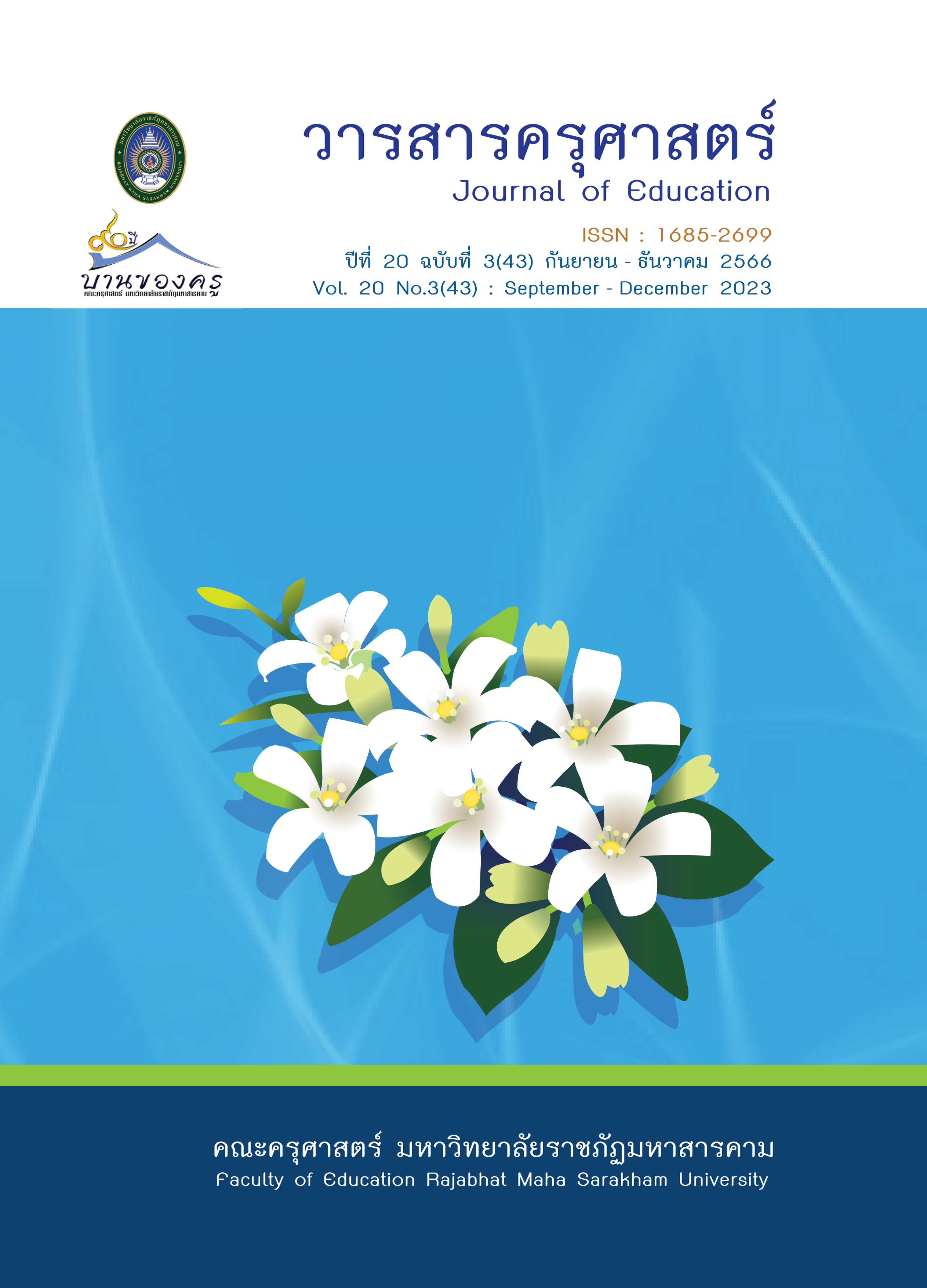The Development of Learning Activities on the use of Microsoft Power Point 2016 Program by Using Projects as A Base for Students in Grade 4
Main Article Content
Abstract
The objectives of this research were 1) to develop learning activities a About using the program Microsoft Power Point 2016 by using the project as a base. for grade 4 pupils who perform (E1/E2) according to the criterion 75/75 2) to compare the achievements of grade 4 pupils after manage learning about the use of Microsoft Power Point 2016 by using the project as a basis with the criterion of 75 percent. 3) to study the satisfaction of students towards learning activities. Using Microsoft Power Point 2016 by using the project as a base. The target group used in this research was 20 students in grade 4, semester 2, academic year 2022, obtained by purposive sampling. The tools used in the research consisted of (1) 7 plans of learning management using project-based learning activities (2) 30 items, four-choice multiple-choice learning achievement test, and (3) a questionnaire on student satisfaction towards the activities of using the Microsoft Power Point 2016 program by using the project as a basis Rating Scales according to Likert’s method were 10 items. Statistics used in data analysis were percentage, mean, standard deviation and t-test (One Samples).
The research found that 1) Learning activities for using the program Microsoft Power Point 2016 by using the project as a base. of Grade 4 students’ efficiency was 79.83/80.33, which was higher than the specified criterion of 75/75. The base value was 24.10, representing 80.33 percent, which was higher than the 75 percent criterion set for statistical significance at .05 and 3) students were satisfied with the learning activities. computer assembly using project-based learning activities Very high (x̅=4.66, S.D.=0.29)
Article Details

This work is licensed under a Creative Commons Attribution-NonCommercial-NoDerivatives 4.0 International License.
ข้อกำหนดเบื้องต้นที่ผู้นิพนธ์(ผู้ส่งบทความ) ควรทราบ
1. ผู้นิพนธ์ที่ประสงค์จะลงตีพิมพ์บทความกับวารสาร ตั้งแต่เดือนมกราคม 2563 เป็นต้นไป ให้ใช้รูปแบบใหม่ (Template 2563) โดยสามารถดูตัวอย่างได้ที่เมนู GUIDELINES
2. จะตีพิมพ์และเผยแพร่ได้ ต้องผ่านการประเมินจากผู้ทรงคุณวุฒิ (Peer Review)
3. การประเมินบทความโดยผู้ทรงคุณวุฒิ (Peer Review) เป็นแบบ Double Blind
4. การอ้างอิงบทความใช้หลักเกณฑ์ APA (American Psychological Association) คลิก
5. บทความถูกปฏิเสธการตีพิมพ์ ไม่ผ่านการประเมิน ผู้นิพนธ์ขอยกเลิกเองหรือชำระเงินก่อนได้รับการอนุมัติ ทางวารสารไม่มีนโยบายการคืนเงิน
References
กนกอร สะภา. (2559). การพัฒนาแผนการจัดการเรียนรู้ตามแนวคิดของกานิเย่ประกอบบทเรียนบนเว็บ รายวิชางานธุรกิจ ชั้นมัธยมศึกษาปีที่ 3. (วิทยานิพนธ์ปริญญามหาบัณฑิต). มหาวิทยาราชภัฏมหาสารคาม.
กนิษฐา บางภู่ภมร. (2559). การพัฒนารูปแบบการเรียนการสอนแบบห้องเรียนกลับด้านร่วมกับกาเรียนรู้แบบนำตนเองเพื่อส่งเสริมความสามารถในการคิดวิเคราะห์ของนักศึกษาระดับปริญญาตรี. (ดุษฎีนิพนธ์ปริญญาปรัชญาดุษฎีบัณฑิต). มหาวิทยาลัยเทคโนโลยีพระจอมเกล้าพระนครเหนือ.
กระทรวงศึกษาธิการ. (2556). นโยบายการศึกษาปี 2556. ชุมนุสหกรณ์การเกษตรแห่งประเทศไทย.
กฤติยา อริยา. (2559). การพัฒนารูปแบบการเรียนการสอนตามแนวคิดการจัดการเรียนการสอนที่เน้นความแตกต่างระหว่าง บุคคลเพื่อส่งเสริมความสามารถในการออกแบบการจัดการเรียนรู้ในศตวรรษที่ 21 ของนักศึกษาครูมหาวิทยาลัยราชภัฏ. (ดุษฎีนิพนธ์ปริญญาการศึกษาดุษฎีบัณฑิต). มหาวิทยาลัยนเรศวร.
กัญญ์ภัคญา อินนุรักษ์ . (2558). การพัฒนาบทเรียนคอมพิวเตอร์ช่วยสอนบนเครือขาย้อนเทอร์เน็ต วิชาโปรแกรมมัลติมีเดียเพื่อการนำเสนอแบบฐานสมรรถนะด้วยการจัดการเรียนรู้แบบโครงงานี้เป็นฐาน. (วิทยานิพนธ์ปริญญามหาบัณฑิต). มหาวิทยาลัยเทคโนโลยีพระจอมเกล้าพระนครเหนือ.
ขัตติยา ยะโกะ. (2558). ผลของการเรียนการสอนโดยใช้โครงงานที่มีต่อความสามารถในการเขียนภาษาอังกฤษและความพึงพอใจในการเรียนของนักเรียนชั้นประถมศึกษาปีที่ 5 โรงเรียนบ้านจะแลเกาะ จังหวัดนราธิวาส. (วิทยานิพนธ์ปริญญามหาบัณฑิต). มหาวิทยาลัยสุโขทัยธรรมาธิราช.
เขมณัฏฐ์ มิ่งศิริธรรม. (2559). การออกแบบสื่อการศึกษาสร้างสรรค์. จุฬาลงกรณ์มหาวิทยาลัย.
คณาจารย์ภาควิชาวิจัยและพัฒนาการศึกษา. (2551). พื้นฐานการวิจัยการศึกษา (พิมพ์ครั้งที่ 6). ภาควิชาหลักสูตรและการสอน คณะศึกษาศาสตร์ มหาวิทยาลัยมหาสารคาม.
จารุวรรณ สิทธิจันทร์. (2558). การพัฒนาบทเรียนบนเว็บแบบโครงงานเป็นฐาน วิชา เทคโนโลยีสารสนเทศและการสื่อสาร ชั้นมัธยมศึกษาปีที่ 5. (วิทยานิพนธ์ปริญญามหาบัณฑิต). มหาวิทยาลัยราชภัฏมหาสารคาม.
จารุวัลย์ ธรรมศิริ. (2561). ผลการจัดการเรียนรู้แบบโครงงานที่มีต่อความสามารถในการทาโครงงาน วิชาคอมพิวเตอร์ของนักเรียนชั้นประถมศึกษาปีที่ 5. (วิทยานิพนธ์ปริญญามหาบัณฑิต). มหาวิทยาลัยราชภัฏนครสวรรค์.
จิราภรณ์ พรมสืบ. (2559). การศึกษาผลสัมฤทธิ์ทางการเรียนและความพึงพอใจของนักเรียนชั้นมัธยมศึกษาปีที่ 1 ด้วยการจัดกิจกรรมการเรียนรู้แบบร่วมมือโดยเทคนิคแบ่งกลุ่มคละผลสัมฤทธิ์ (STAD) รายวิชาวิทยาศาสตร์ หน่วยการเรียนรู้ เรื่อง สารละลายกรดและเบส.(วิทยานิพนธ์ปริญญามหาบัณฑิต). มหาวิทยาลัยบูรพา.
ชวลิต ชูกำแพง. (2551). การพัฒนาหลักสูตร. มหาวิทยาลัยสารคาม.
ถนอมพร เลาหจรัสแสง. (2541). คอมพิวเตอร์ช่วยสอน. ศูนย์หนังสือจุฬาลงกรณ์มหาวิทยาลัย.
พระราชบัญญัติการศึกษาแห่งชาติ พ.ศ. 2542. (2542,19 สิงหาคม). ราชกิจจานุเบกษา. เล่มที่ 116. (ตอนที่ 74 ก), หน้า 1-23.
รัตนชัย ทาตัน. (2559). การเปรียบเทียบผลสัมฤทธิ์ทางการเรียน ความคิดสร้างสรรค์ และเจตคติต่อการเรียนการเรียนคอมพิวเตอร์ ระหว่างการเรียนรู้แบบโครงงานกับการเรียนรู้แบบแก้ปัญหาเชิงสร้างสรรค์ ของนักเรียนชั้นมัธยมศึกษาปีที่ 5. (วิทยานิพนธ์ปริญญามหาบัณฑิต). มหาวิทยาลัยราชภัฏมหาสารคาม.
โรงเรียนอนุบาลรุ่งเรืองวัฒนา. (2564). รายงานการประเมินตนเอง (SAR). ร้อยเอ็ด.
สมนึก ภัททิยธนี. (2551). การวัดผลการศึกษา (พิมพ์ครั้งที่ 5). ประสานการพิมพ์.
สำนักวิชาการและมาตรฐานการศึกษา. (2553). แนวทางการจัดการเรียนรู้ ตามหลักสูตรแกนกลางการศึกษาขั้นพื้นฐาน พุทธศักราช 2551 (พิมพ์ครั้งที่ 2). โรงพิมพ์ชุมนุมสหกรณ์การเกษตรแห่งประเทศไทย จำกัด.
อังคณา ตุงคะสมิต. (2559). สังคมศึกษาในโลกอาเซียน Social studies in ASEAN Community. โรงพิมพ์มหาวิทยาลัยขอนแก่น.
Ardaiz-Villanueva, O., Nicuesa-Chacón, X., Brene-Artazcoz, O., Sanz de AcedoLizarraga,M.L. and Sanz de Acedo Baquedano, M.T. (2011). Evaluation ofcomputer toolsfor idea generation and team formation in project-basedlearning. Computers& Education, 56(3), 700-711.
Bender, W.N. (2012). Project-Based Learning: Differentiating Instruction for the 21st Century. California : CORWIN A SAGE Company.
Duran, M. and Şendağ, S. (2012). A Preliminary Investigation into Critical ThinkingSkillsof Urban High School Students: Role of an IT/STEM Program. Creative Education, 3, 241-250.
Kanokkorn Medtajit. (2558). The Effects of A Program Integrating Goal Setting Into Inquiry Teaching Method on Achievement Motivation and Achievement in Science Subject of Mathayom Suksa 2 Nawaminthrachinuthit Bodindecha Schooo (Bodin 3). Journal of MCU Social Science Review, 4(1), 180-189.


